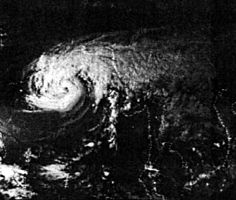| Very severe cyclonic storm (IMD) | |||
|---|---|---|---|
| Category 3 tropical cyclone (SSHS) | |||
 The Bhola cyclone on November 11, 1970, at 0858 UTC. | |||
| Formed | November 7, 1970 | ||
| Dissipated | November 13, 1970 | ||
| Highest winds |
| ||
| Lowest pressure | 966 mbar (hPa; 28.53 inHg) | ||
| Fatalities | 300,000–500,000 (Deadliest tropical cyclone of all time) | ||
| Damage | $86.4 million (1970 >USD)$480 million (2010 USD) | ||
| Areas affected | India, East Pakistan | ||
| Part of the1970 North Indian Ocean cyclone season | |||
The 1970 Bhola cyclone was a devastating tropical cyclone that struck East Pakistan (now Bangladesh) and India's West Bengal on November 12, 1970. It was the deadliest tropical cyclone ever recorded, and one of the deadliest natural disasters in modern times.[2] Up to 500,000 people lost their lives in the storm, primarily as a result of the storm surge that flooded much of the low-lying islands of the Ganges Delta. This cyclone was the sixth cyclonic storm of the 1970 North Indian Ocean cyclone season, and also the season's strongest, reaching a strength equivalent to a Category 3 hurricane.
The cyclone formed over the central Bay of Bengal on November 8 and travelled north, intensifying as it did so. It reached its peak with winds of 185 km/h (115 mph) on November 12, and made landfall on the coast of East Pakistan that night. The storm surge devastated many of the offshore islands, wiping out villages and destroying crops throughout the region. In the most severely affected Thana, Tazumuddin, over 45% of the population of 167,000 was killed by the storm.
The Pakistani government was severely criticized for its handling of the relief operations following the storm, both by local political leaders in East Pakistan and in the international media. The opposition Awami League gained a landslide victory in the province, and continuing unrest between East Pakistan and the central government triggered the Bangladesh Liberation War, which concluded with the creation of the country of Bangladesh.
DEATH TOLL
The cyclone formed over the central Bay of Bengal on November 8 and travelled north, intensifying as it did so. It reached its peak with winds of 185 km/h (115 mph) on November 12, and made landfall on the coast of East Pakistan that night. The storm surge devastated many of the offshore islands, wiping out villages and destroying crops throughout the region. In the most severely affected Thana, Tazumuddin, over 45% of the population of 167,000 was killed by the storm.
The Pakistani government was severely criticized for its handling of the relief operations following the storm, both by local political leaders in East Pakistan and in the international media. The opposition Awami League gained a landslide victory in the province, and continuing unrest between East Pakistan and the central government triggered the Bangladesh Liberation War, which concluded with the creation of the country of Bangladesh.
DEATH TOLL
| Thana | Pre-cyclone population | Reported deaths | Mortality (%) |
|---|---|---|---|
| Kalapara | 88,000 | 8,000 | 9 |
| Amtali | 41,000 | 2,000 | 5 |
| Galchipa | 319,000 | 45,000 | 14 |
| Char Fasson | 171,000 | 38,000 | 22 |
| Lalmohan | 104,000 | 23,000 | 22 |
| Tazumuddin | 167,000 | 77,000 | 46 |
| Hatiya | 219,000 | 18,000 | 8 |
| Ramgati> | 217,000 | 24,000 | 11 |
| Sudharam | 35,000 | 6,000 | 17 |
| Total | 1,361,000 | 251,000 | 17.7 |

No comments:
Post a Comment